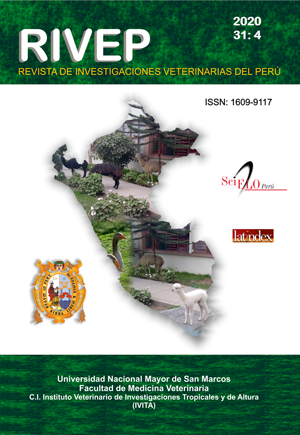Serological and molecular frequency of Leishmania spp and Trypanosoma cruzi and associated factors in dogs with signs suggestive of trypanosomatid infection in Quintana Roo, Mexico
DOI:
https://doi.org/10.15381/rivep.v31i4.17336Keywords:
dogs, indirect immunofluorescence, Leishmania spp, PCR, trypanosomatids, Trypanosoma cruziAbstract
A cross-sectional study was conducted with a sample of 40 dogs with clinical signs suggestive of infection by Leishmania spp and Trypanosoma cruzi in the municipality of Lázaro Cárdenas, Quintana Roo, Mexico. Blood, skin and bone marrow samples were taken. Indirect immunofluorescence (IFI) tests for detection of anti-Leishmania infantum and immunochromatic test for the detection of anti-Trypanosoma cruzi antibodies in serum were performed. In addition, molecular analyses were performed using PCR to detect Leishmania spp in bone marrow and skin and T. cruzi in bone marrow. Histopathological analyses of the skin and cytology of the bone marrow were carried out in search of lesions and trypanosomatid agents. The results showed that 3 (7.5%) and 6 (15%) dogs with anti-L. infantum and T. cruzi antibodies were detected, respectively. Molecular analyses detected 17 dogs positive for infection by T. cruzi (42.5%) and none for infection by Leishmania spp. Dogs with low body condition showed greater seropositivity to T. cruzi using Fisher’s exact test (p<0.05). Parasites of the genus Leishmania did not actively participate in the pathological processes of the animals; however, a high frequency of animals infected with T. cruzi was observed.
Downloads
Downloads
Published
Issue
Section
License
Copyright (c) 2020 Enrique Salazar Grosskelwing, Manuel Emilio Bolio González, Roger Iván Rodríguez Vivas, Guadalupe Miró Corrales, Francisco Javier Escobedo Ortegón, Hugo Antonio Ruíz Piña, Elsy Nalleli Loría Cervera

This work is licensed under a Creative Commons Attribution-NonCommercial-ShareAlike 4.0 International License.
AUTHORS RETAIN THEIR RIGHTS:
a. Authors retain their trade mark rights and patent, and also on any process or procedure described in the article.
b. Authors retain their right to share, copy, distribute, perform and publicly communicate their article (eg, to place their article in an institutional repository or publish it in a book), with an acknowledgment of its initial publication in the Revista de Investigaciones Veterinarias del Perú (RIVEP).
c. Authors retain theirs right to make a subsequent publication of their work, to use the article or any part thereof (eg a compilation of his papers, lecture notes, thesis, or a book), always indicating the source of publication (the originator of the work, journal, volume, number and date).



